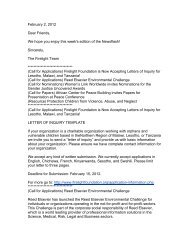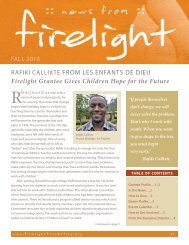From Faith to Action - Faith to Action Initiative
From Faith to Action - Faith to Action Initiative
From Faith to Action - Faith to Action Initiative
- No tags were found...
Create successful ePaper yourself
Turn your PDF publications into a flip-book with our unique Google optimized e-Paper software.
Residential CareBased on Family ModelsOrphanages that serve large numbers of children in a singlefacility are not able <strong>to</strong> provide the individualized care thatchildren require. In an effort <strong>to</strong> address this, some largerinstitutions are transitioning in<strong>to</strong> smaller group homesmodeled on family life. Children live in small, mixed-agegrouphouseholds with trained “houseparents” who areable <strong>to</strong> provide more personal and consistent care.Once a child has been placed in aninstitution, every effort should bemade <strong>to</strong> fi nd reliable family care.Out of Orphanagesand In<strong>to</strong> the CommunityIn some regions and communities, efforts are being made <strong>to</strong>replace orphanages with family-based care. Resources that wereonce used <strong>to</strong> maintain institutions are now used <strong>to</strong> reunitechildren with their families and, when this is not possible,<strong>to</strong> recruit, train, and moni<strong>to</strong>r foster parents. Older youth areprovided with assistance in areas such as vocational trainingand setting up households <strong>to</strong> help them gain independence inthe community.Child Protection Society (CPS), Harare, ZimbabweChild Protection Society is one of the Zimbabwe’s oldest child welfareorganizations. For many years, CPS operated a large dormi<strong>to</strong>rystylechildren’s home called Chinyaradzo. In 2002, CPS soughtand received funds <strong>to</strong> convert part of Chinyaradzo in<strong>to</strong> six smallerunits based on a family model. In each home, carefully selected andtrained houseparents care for eight <strong>to</strong> ten children ranging in agefrom infancy <strong>to</strong> 18 years. The units are <strong>to</strong>tally integrated in<strong>to</strong> thecommunity, with no signage identifying them with CPS. The childrenattend local schools and play with neighbor children. This approachgives the children an opportunity <strong>to</strong> build personal relationships,while providing them with greater emotional security and a sense ofbelonging. Life skills training is offered <strong>to</strong> help youth prepare for theirfuture in the larger society. Opportunities <strong>to</strong> develop friendships andmen<strong>to</strong>ring relationships with people in the community are key <strong>to</strong> theprogram’s success.Having observed fi rsthand the limitations of institutional care, CPSalso initiated a community-based program <strong>to</strong> support children infamily care in urban Harare. Subscribing <strong>to</strong> the ideal that everychild should have the right <strong>to</strong> experience family life, CPS works <strong>to</strong>promote foster care and actively lobbies against the establishment oforphanages.Jerusalem Children and Community DevelopmentOrganization (JeCCDO), Addis Ababa, EthiopiaJeCCDO, formerly known as Jerusalem Association Children’sHomes, established four residential institutions in response <strong>to</strong> theneeds of children who were orphaned by civil war, drought, and theresulting famine of 1984. In 1996, the management began a fi ve-yearstrategic planning and assessment process that led <strong>to</strong> their decision<strong>to</strong> de-institutionalize based on a number of fac<strong>to</strong>rs. Staff observedthat youth lacked exposure <strong>to</strong> community life and had a diffi cult timesustaining themselves when they left the orphanages. JeCCDO alsorecognized that the costs of residential care were high, limiting thenumber of children they could assist.JeCCDO’s team developed a plan that included a number of creativestrategies. Staff went with children <strong>to</strong> their birthplaces <strong>to</strong> track downtheir families and relatives. Some parents, separated from theirchildren for years, had not even realized that they were alive. In caseswhere reunifi cation was not possible, foster families were found.Families were provided with a small grant <strong>to</strong> cover resettlementcosts for the child. JeCCDO social workers made follow-up visits <strong>to</strong>the children as they adjusted <strong>to</strong> their new lives. To date, JeCCDOhas reunifi ed and reintegrated nearly 1,000 children in<strong>to</strong> familyhouseholds. For orphans aged 15 and over in need of independentliving arrangements, JeCCDO provided vocational training andincome-generating activities along with a small amount of initialcapital for each youth. JeCCDO now operates integrated communitybasedcare programs throughout a large part of the country, helpingmany children and youth remain in family care.21








